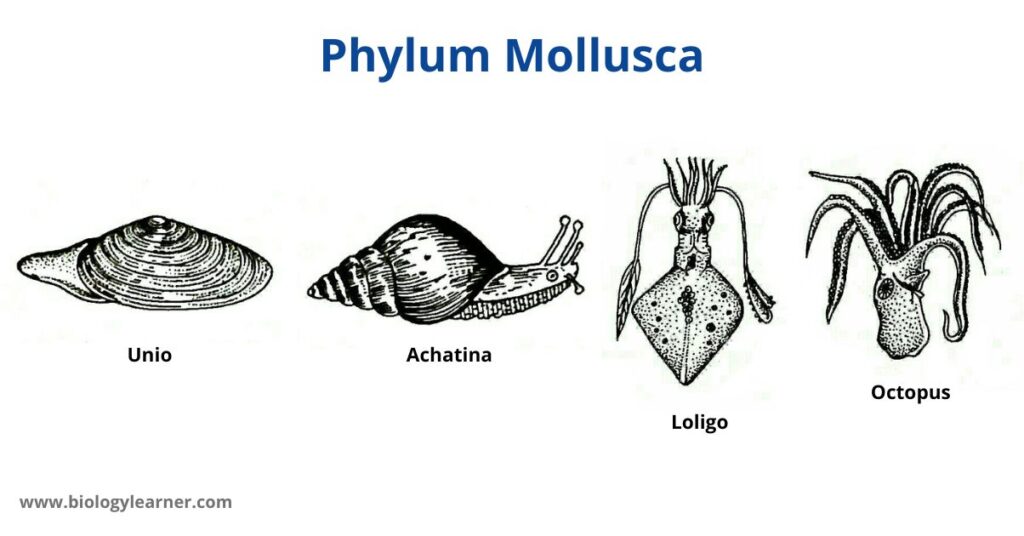Phylum Mollusca is the second largest invertebrate phylum containing more than 90000 described living species after phylum Arthropoda. Johnston has first coined the name Mollusca in 1650.
Although Aristotle was probably the first person to recognize the mollusks. He divided them into two groups Malachia and Ostrachodermata. Malachia including the cephalopods and Ostrachodermata include all shelled organisms.
The name Mollusca is derived from the Latin word Mollis. “Mollis = Soft“
The animals of this phylum have soft bodies. Most of the animals are marine and some are freshwater form.
Mollusca Definition
Phylum Mollusca is the group of animals having bilaterally symmetrical coelomate soft type bodies with a well-developed nervous system showing cephalization, foot, dorsal mantle, and the visceral mass.

Characteristics of Mollusca
Some common characteristic features of the phylum Mollusca are:
- Bilaterally symmetrical, unsegmented, and soft body.
- All animals in this group are triploblastic.
- The true coelom is present in the body which is reduced to small spaces surrounding the heart, nephridia, and part of the intestine.
- The coelom is filled with the blood to form Hemocoel.
- The body is divided into three regions- the muscular foot, head, and visceral mass.
- The body or visceral mass is covered by a thick epidermal cuticular sheet of skin called the mantle.
- Calcium is secreted from the mantle membrane to form the shell. The shell is usually located outside the body. In some animals, the shell is located inside the body (Sepia) or is not present (Octopus).
- The alimentary canal is complete and well-developed and digestive glands and liver are present.
- Respiration occurs by ctenidia, mantle membrane, or pulmonary sac.
- The excretory organ is the kidney, Which is known as the organ of Bojanus.
- The circulatory system is a close and partially open type. The blood contains pigment hemocyanin.
- Presence of sense organs like the eye (Loligo), tentacles (Sepia), osphradium ( Helps to determine the chemical nature of water), and statocyst (Helps to maintain balance).
- Most of the animals are unisexual, some are bisexual or hermaphrodite.
- Trochophore or Veliger larva is present in their life cycle.
Identification Characters
- Body structure: The body is unsegmented, soft, and muscular type.
- Body membrane: The body is covered by the epidermal cuticular mantle.
- Foot: Muscular foot is present in the ventral part of the body.
- Organelles: The body has a distinct head, tentacles, and sensory organs.
- Digestive system: Complete and well-developed elementary canal and digestive glands are present.
Examples
Some common mollusks are Pila, Sepia, Unio, Octopus, Loligo, Helix, Chiton, Pinctada, Aplysia, Mytilus, Achatina, etc.
Classification of Mollusca
Phylum Mollusca is divided into six classes.
The outline of the classification is given below:
Class 1. Monoplacophora (e.g., Neopilina)
Class 2. Amphineura
- Subclass 1. Aplacophora (e.g., Chaetoderma)
- Subclass 2. Polyplacophora
- Order 1. Lepidopleurina (e.g., Lepidopleurus)
- Order 2. Chitonida (e.g., Chiton)
Class 3. Scaphopoda (e.g., Dentalium)
Class 4. Gastropoda
- Subclass 1. Prosobranchia
- Order 1. Archaeogastropoda (e.g., Trochus)
- Order 2. Mesogastropoda (e.g., Pila)
- Order 3. Neogastropoda (e.g., Murex)
- Subclass 2. Opisthobranchia
- Order 1. Cephalaspidea (e.g., Acteon)
- Order 2. Anaspidea (e.g., Aplysia)
- Order 3. Pteropoda (e.g., Spiratella)
- Order 4. Saccoglossa (e.g., Oxynoe)
- Order 5. Acochilidiacea (e.g., Acochlidium)
- Order 6. Notaspidea (e.g., Tylodina)
- Order 7. Nudibranchia (e.g., Doris)
- Order 8. Pyramidellacea (e.g., Odostomia)
- Order 9. Philinoglossacea (e.g., Philinoglossa)
- Order 10. Rhodopacea (e.g., Rhodope)
- Order 11. Onchidiacea (e.g., Onchidium)
- Order 12. Parasita (e.g., Entoconcha)
- Subclass 3. Pulmonata
- Order 1. Basommatophora (e.g., Lymnaea)
- Order 2. Stylommatophora (e.g., Helix)
Class 5. Pelecypoda
- Order 1. Protobranchia (e.g., Nucula)
- Order 2. Filibranchia (e.g., Area)
- Order 3. Pseudolamellibranchia (e.g., Ostraea)
- Order 4. Eulamellibranchia (e.g., Unio)
- Order 5. Septibranchia (e.g., Cuspidaria)
Class 6. Cephalopoda
- Subclass 1. Coeloidea
- Order 1. Decapoda (e.g., Loligo)
- Order 2. Octopoda (e.g., Octopus)
- Subclass 2. Nautiloidea (e.g., Nautilus)
- Subclass 3. Ammonoidea (e.g., Ammonites)
